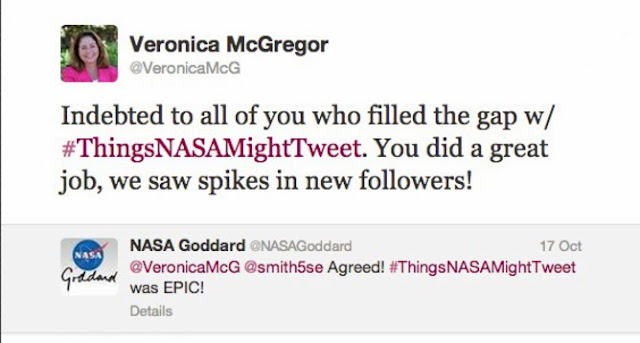How Twitter fans kept NASA alive during the US shutdown
21 October 2013, 4.27am BST
NASA has built up a strong network of science enthusiasts who can step in when the agency shuts down. NASA HQ PHOTO
During the past few weeks, many have made their thoughts on the shutdown of science known on Twitter. In the world of space science, there was distinct lack of news and mission updates from the network of telescopes, spacecraft and rovers around our solar system — no @NASA, @NASA_Hubble, @MarsCuriosity or @NASAVoyager… the list could continue for the hundreds of NASA twitter accounts.
NASA’s Twitter account and other public communication efforts at a standstill during the US government shutdown.
For those unfamiliar with Twitter lore, the hashtag was implemented by Twitter users themselves in 2007 to enable people to engage with topics of interest outside the follower networks—so they didn’t have to “eavesdrop” on conversations. Social media scholars Axel Bruns and Jean Burgess note that hashtags are aimed at “imagined communities” or an “ad hoc public”.
Within this community, the #ThingsNASAMightTweet-ers weren’t just exchanging news amongst themselves: they were recreating a service on which a broad range of people had come to rely. Some tweeters had scientific expertise, some were NASA staff, most were an interested public. Effectively, an international public took on the communication role of a US government agency — possibly a first in the annals of governance.
The topics covered by the #ThingsNASAMightTweet-ers included the Lunar Atmosphere and Dust Environment Explorer (LADEE), Lunar Reconnaissance Orbiter, International Space Station, Mars Odyssey orbiter, Juno spacecraft and the impending arrival of the Orionids, a meteor shower which occurs every October. When people posed space questions to NASA on Twitter, they were answered by others with expertise in the relevant area.
This image of Earth is one of the first snapshots sent back home by NASA’s Juno spacecraft during its flyby on October 9, 2013. NASA/JPL/SwRI/MSSS/Ken Kremer
It brings to mind Voltaire’s much-cited aphorism about God: if NASA didn’t exist, it would be necessary to invent it. It was a clear statement of how the space community felt about the role of NASA social media in its collective life.
It’s hard to know what impact #ThingsNASAMightTweet had beyond the space community; this may have to wait for more sustained analysis. But the campaign did not go unnoticed in other media, being reported by the Los Angeles Times, NBC News and a number of international websites.
Thanks to the profile of the hashtag, we didn’t miss events that occurred during the shutdown, like NASA’s 55th birthday and the Juno spacecraft doing a cool fly-by of Earth en route to Jupiter.
This public support for NASA wasn’t born only out of people’s love of space and exploration. Since NASA began using social media, they have endeavoured to create a community of science enthusiasts.
Since 2009, NASA has been running events called NASA Socials. The concept is ingenious: a bunch of interested people come to NASA facilities, see rocket launches, meet astronauts, see rovers in clean rooms. They share their behind-the-scenes experience with their friends and followers on social networks like Twitter, Facebook and Google+.
NASA have hosted countless Socials, and the Space Tweep Society is a thriving online community. It’s a huge benefit of “engaging the engaged”, when fostering geek love turns into community action, the community using social media as its voice.
A response to the hashtag from @VeronicaMcG, News and Social Media Manager at NASA’s Jet Propulsion Laboratory.
NASA, it’s good to have you back: at least for the 87 days until Congress can push the shutdown button again. We all need our space.





No comments:
Post a Comment